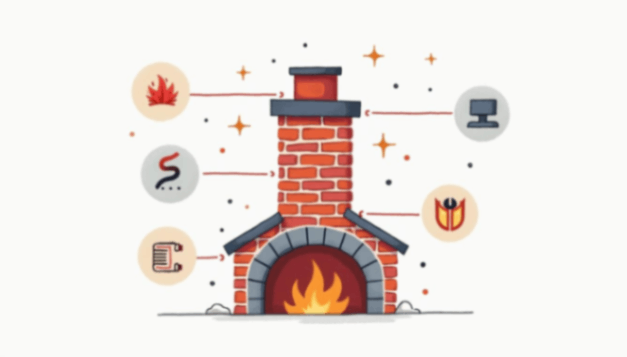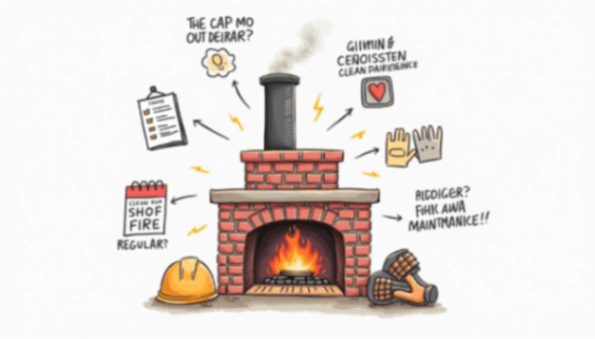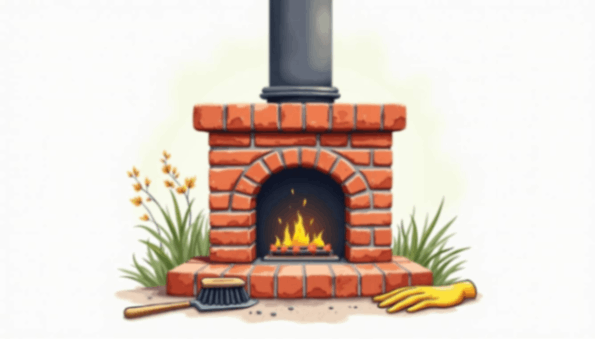Chimneys play an essential role in venting the smoke and gases produced by your fireplace or stove, ensuring that your home remains safe and free from harmful fumes. However, like any other component of a home, chimneys can develop problems over time. This article will delve into the common issues faced by chimneys, how to identify them, preventative measures, and DIY fixes to keep your chimney functioning effectively.
Understanding Your Chimney: A Brief Overview
Before we tackle the common problems associated with chimneys, it's essential to understand their function and structure. A chimney is much more than just a stack of bricks; it serves vital purposes in your home.

The Role and Importance of a Chimney
The primary role of a chimney is to vent smoke and combustion gases safely from the home. This process protects the occupants from harmful pollutants, including carbon monoxide, which can be life-threatening when inhaled. Furthermore, a well-functioning chimney improves the efficiency of your fireplace or stove, enhancing your overall heating experience. In addition to these practical functions, chimneys also contribute to the aesthetic appeal of a home. A beautifully designed chimney can complement the architectural style of your house, adding character and charm. Whether it’s a classic brick chimney or a sleek metal flue, the visual impact of a chimney should not be underestimated.
Basic Components of a Chimney
Understanding the components of a chimney will help homeowners recognize potential problems. The main parts of a chimney include:
- Flue: The inner lining that directs smoke and gases outside.
- Crown: The top part of the chimney that prevents water infiltration.
- Chimney Cap: A cover for the top of the chimney that keeps debris and animals out.
- Chimney Shaft: The outer structure, usually made of masonry or metal.
Each of these components plays a critical role in maintaining your chimney’s functionality and safety. For instance, the flue must be kept clean and free of blockages to ensure proper airflow; otherwise, dangerous gases can back up into the living space. Regular inspections and maintenance are crucial to identify any wear and tear, particularly in the chimney cap and crown, which are often exposed to harsh weather conditions. Additionally, understanding how these components work together can empower homeowners to take proactive measures, such as installing a high-quality chimney cap to prevent animal intrusions, which can lead to costly repairs and safety hazards.
Identifying Common Chimney Problems
Understanding the common issues that can arise within a chimney system is vital for maintaining safety and performance. Here, we discuss the problems that can affect chimneys, how to spot them early, and what consequences they may bring.
Creosote Buildup
One of the most common issues with chimneys is creosote buildup. Creosote is a black or brown residue that forms when wood burns. If left unaddressed, creosote deposits can lead to chimney fires. Signs of creosote buildup include an intense smell when the fireplace is in use or dark, tar-like substances present in the flue. Regular inspections and cleanings are essential to prevent this hazardous accumulation. Homeowners should aim to have their chimneys swept at least once a year, especially if they use their fireplace frequently. Additionally, using seasoned wood can help reduce the amount of creosote produced, as it burns cleaner than green or unseasoned wood.
Blockages and Obstructions
Blockages can occur due to various reasons, including bird nests, fallen debris, or even soot accumulation. These obstructions can prevent smoke from exiting the chimney, causing smoke to backflow into your home. Warning signs include difficulty lighting a fire, persistent foul odors, or smoke in the living area. It’s crucial to check for blockages, especially during the spring and fall when birds may be nesting. Installing a chimney cap can help prevent animals from entering and can also keep out leaves and other debris, ensuring a clear passage for smoke and gases.
Structural Damage
Structural issues can arise due to age, weather exposure, or improper installation. Cracks in the masonry, crumbling bricks, or a leaning chimney can indicate significant underlying problems. Homeowners should conduct visual inspections and monitor for any changes in alignment or stability. In addition to visual checks, it’s advisable to look for signs of spalling, where the outer layer of brick begins to break away due to moisture infiltration. If structural damage is suspected, consulting a professional is essential, as they can provide a thorough assessment and recommend necessary repairs to prevent further deterioration.
Flue Damage
The flue liner protects the chimney’s structural integrity and aids in venting smoke. Damage to the flue—whether through corrosion, cracks, or improper sizing—can compromise the entire system. Indicators of flue damage include rust stains, unusual smoke patterns, or an increased presence of debris inside the chimney. Regular chimney inspections, particularly after severe weather events, can help identify flue issues early. Homeowners should also consider upgrading to a more durable flue liner, such as stainless steel, which can withstand higher temperatures and resist corrosion over time.
Water Leaks and Moisture Problems
Water damage is another significant concern for chimney health. Rainwater can enter through cracks or without a proper chimney cap. Moisture can lead to rust, mold growth, and even freeze-thaw damage during colder months. Symptoms to watch for include water stains on the walls near the chimney and dampness in the fireplace or flue. To combat moisture intrusion, homeowners should ensure that their chimney is equipped with a high-quality cap and flashing. Additionally, applying a waterproof sealant to the exterior of the chimney can provide an extra layer of protection against the elements, helping to prolong the lifespan of the chimney and maintain its functionality.
Prevention Measures for Chimney Problems
Taking preventative measures is crucial to avoid costly repairs and maintain the safety of your chimney. Regular maintenance can significantly reduce the risk of encountering these common issues.

Regular Chimney Inspection
A professional chimney inspection at least once a year is a critical step towards ensuring its wellness. This inspection will identify any potential issues before they escalate. Technicians can assess both the interior and exterior components of your chimney, giving you peace of mind. During the inspection, they will check for structural integrity, signs of wear, and any buildup of harmful substances that could pose a fire hazard. Additionally, they will evaluate the flue and ensure that it is clear and functioning properly, which is essential for the safe venting of smoke and gases.
Chimney Cleaning and Maintenance
Routine cleaning is essential, especially if your fireplace is used frequently. The National Fire Protection Association (NFPA) recommends cleaning the chimney at least once a year or more often based on usage. During cleaning, professionals will remove creosote, soot, and other obstructions. This buildup can not only reduce the efficiency of your chimney but also increase the risk of chimney fires. Furthermore, regular maintenance can include checking the damper for proper operation and ensuring that the smoke chamber is free from any blockages. This proactive approach helps maintain optimal airflow and enhances the overall performance of your fireplace.
Installing a Chimney Cap
A chimney cap can prevent debris, rain, and animals from entering your chimney, helping to reduce the likelihood of blockages and water damage. Furthermore, it can enhance your chimney's efficiency and help direct smoke out effectively. Installing a chimney cap is a simple yet effective preventative measure. Beyond just keeping out unwanted elements, a well-fitted cap can also help prevent downdrafts, which can cause smoke to enter your home instead of venting outside. Additionally, many chimney caps come with mesh screens that can keep out small animals, such as birds and squirrels, which can create nests and lead to further obstructions. Investing in a quality chimney cap not only protects your chimney but also contributes to a safer and more efficient fireplace experience.
DIY Fixes for Common Chimney Issues
For homeowners who prefer to take matters into their own hands, there are several DIY fixes to address minor chimney problems. However, it’s essential to know your limits and seek professional help when needed.

Removing Creosote Buildup
To safely remove creosote, use a chimney brush specifically designed for this task. Ensure you don protective gear, such as goggles and a mask, to avoid inhalation. Regular brushing can significantly reduce the amount of creosote and lower the risk of chimney fires. Additionally, consider using a creosote remover product that can help break down the buildup, making it easier to clean. These products often come in the form of powders or logs that you can burn in your fireplace, which can help to reduce creosote accumulation over time.
Clearing Chimney Blockages
For minor blockages, you can try using a vacuum cleaner equipped with a HEPA filter. This method can help remove loose debris and soot. However, more severe blockages may require professional intervention for a thorough clearing. It's also a good idea to inspect the chimney cap and flue for any signs of animal nests or debris that may be obstructing airflow. If you discover any foreign objects, carefully remove them to restore proper ventilation and prevent smoke from backing up into your home.
Repairing Minor Structural Damage
For small cracks or spalling bricks, you can use a masonry repair compound to patch up minor imperfections. Ensure the area is clean and dry before applying the compound, and follow the manufacturer's instructions for best results. For larger structural issues, always consult a professional. Additionally, consider applying a waterproof sealant to the exterior of your chimney to protect it from moisture damage, which can exacerbate cracks and lead to more significant issues down the line. Regularly checking for signs of wear, such as crumbling mortar or loose bricks, can help you catch problems early before they escalate.
Furthermore, keeping your chimney well-maintained not only enhances its functionality but also contributes to the overall aesthetic of your home. A clean, structurally sound chimney can be a charming feature, adding character and value to your property. Homeowners should also be mindful of the surrounding landscaping; overhanging branches can lead to debris accumulation, while excessive moisture from nearby plants can cause deterioration. Taking proactive steps to maintain both the chimney and its environment will ensure a safe and enjoyable fireplace experience for years to come.










